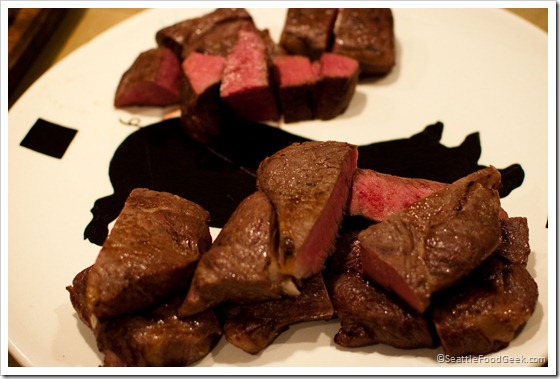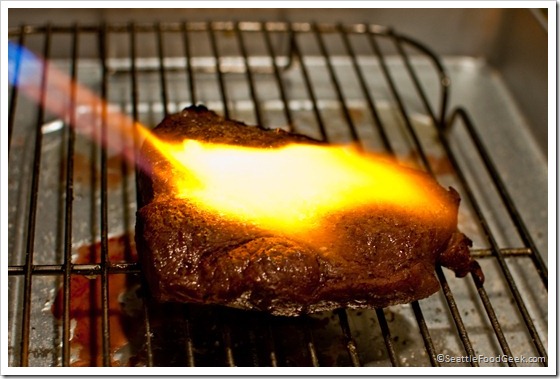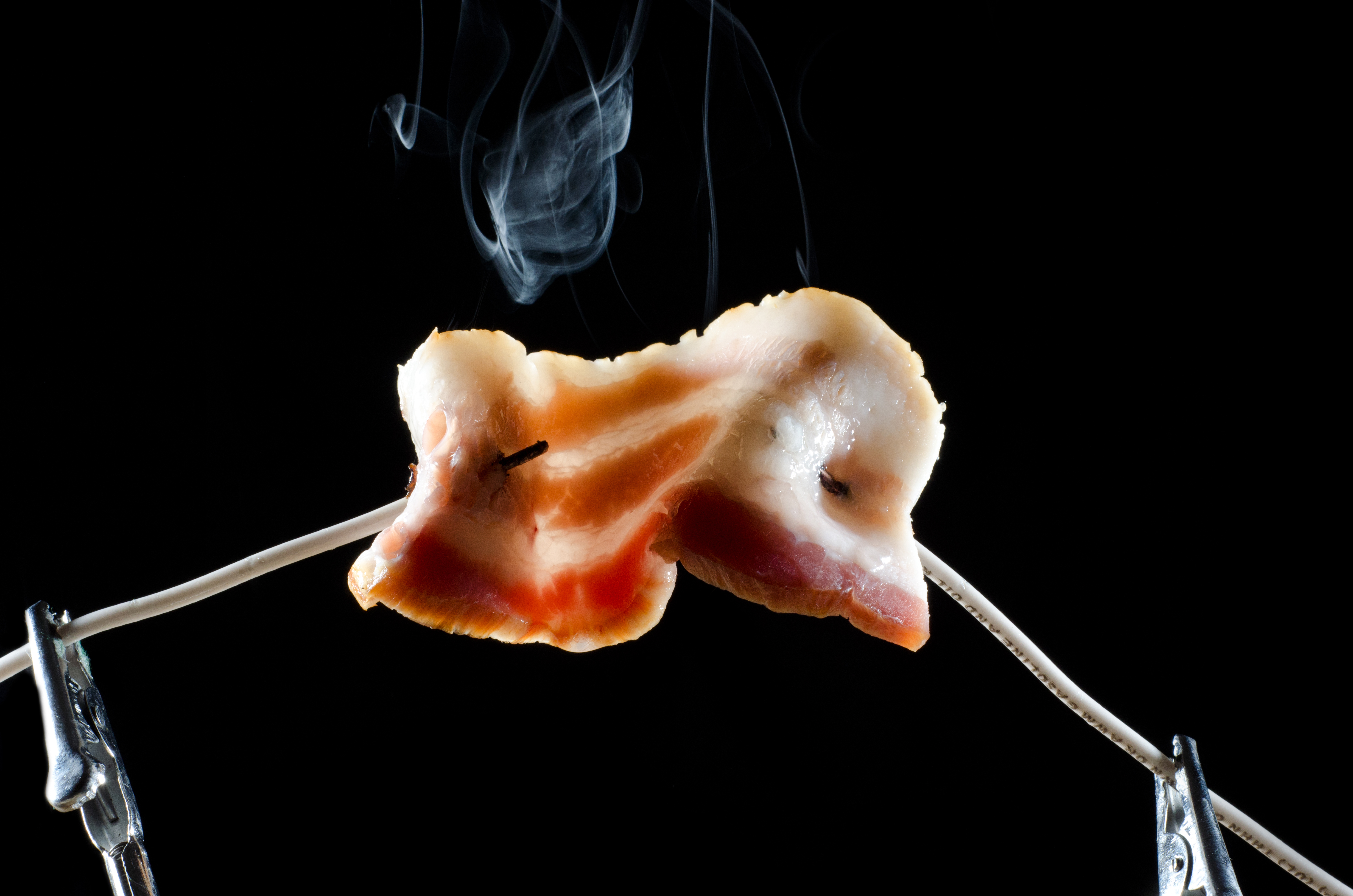
How many adjectives have you used to describe a glass of wine? Smoky, sharp, fruity, complex, perky, aggressive, balanced, lingering, refined… Now, how about coffee? Bold, rich, dark, strong, nutty… Now try beef.
Having a little more trouble with this one, huh? While you may have gone to wine tasting events, or perhaps sampled two or three different coffee blends side by side, or even done blind tastings of chocolate or olive oil, chances are that you’ve never tested your taste buds with steak. In fact, aside from a favorite cut (like T-bone, New York strip, filet and the like) most Americans have no idea what qualities they like in a steak. I know that in wine, for example, I prefer fruity reds with mild tannins and a sweet finish. But up until a few weeks ago, I was totally unaware of my own preferences for that great-American staple: steak. Learning about your own preferences is not only delicious, but also quite a bit of fun.
“But what is there to choose about a steak besides the cut?” you may be asking. Well, in the same way that two bottles of Pinot Noir don’t taste identical just because they come from the same varietal, two New York strips can vary vastly in flavor based on the breed of cattle, the terroir in which the cattle lived and grazed, what the cattle ate, and how the steaks were finished. It is a disgracefully unfortunate fact that we are have little-to-no insight into any of these particulars when we buy steaks at the grocery store. In fact, if you want to piss off the meat man at your local Safeway, pick up a steak and ask him if the cow was treated with steroids, hormones or antibiotics, and if it was fed grass, corn or some type of mystery feed before slaughter. (Note: this is part of the reason that I don’t buy formerly-living things from Safeway, at least not the one near me.) While your average $7 bottle of wine will tell you the year the grapes were harvested, the blend percentage of the varietals, the grape source, where the wine was made, and the alcohol percentage, we’re lucky if our beef packaging even makes mention of the cow’s diet. And even then, you’re rarely getting the whole story.
Luckily, I happened to meet Carrie Oliver at the International Food Bloggers Conference last summer, and get to hear her talk steak. Her company, Oliver Ranch, connects people like you and me with high-quality, traceable, hormone and antibiotic-free beef produced by independent farmers. Their website allows you to order your favorite cuts from one of four independent farms that supply to Oliver Ranch, and your steaks are shipped directly to you, vacuum sealed and flash-frozen. But, in my opinion, the best part of what they offer is the tasters pack. You can choose between filet mignon, New York strip, top sirloin or rib-eye tasting packs that include one or more steaks from each of the farms. The tasting pack comes with a tasting guide, complete background on the ranches and cattle, and even nifty little wood picks that read “medium rare” (incidentally, the only proper way to cook a steak, in my opinion).
I held a steak tasting for 8 people using the four different steaks from the tasting pack, plus one from my local (and well-renowned) butcher. Since the purpose of the tasting, other than to fill up on amazing meat, was to discover everyone’s personal preferences, we made the tasting blind – that is, nobody but me knew which type of steak they were eating until the very end of the meal. In order to ensure consistency, I cooked all of the steaks sous vide to a precise medium rare (53.5C) for two hours. Afterwards, I seasoned the meat with sea salt and seared the outside with a blow torch. So, every steak was the exact same doneness, with the exact same seasoning, with the exact same amount of char. I can say with confidence that this preparation method, as geeky as it was, would stand up to scientific scrutiny.

I cut each of the steaks into small portions and served them clockwise around the tasters’ plates. To round out the meal, a healthy dollop of garlic mashed potatoes and roasted asparagus filled in empty plate space. As we started eating, a chorus of moans, full-mouthed expressions of surprise and delight, worked its way around the table. Not only were the steaks transcendent, but the flavor differences between them were profound. Some steaks carried a strong flavor of grass, others of nutmeg and molasses, still others of wheat and a milieu of subtle tones – just like a glass of fine wine. What’s more impressive, though, is that these differences were not at all lost on the other tasters: my family. Although they certainly appreciate good food, this was not a group of foodies looking to out-taste one another, or people with a vested interest in seeing the emperor’s clothes. These were people who, until that night, didn’t know Holstein from Angus, but now had a reason to find out.
Not surprisingly, everyone had their own opinions on which steak they liked the best. However, in general, the table preferred the two wet-aged steaks: the Holstein-Friesian from the 3 Brand Cattle Company and the Wagyu-Angus Cross from Select Kobe Beef America Ranches. We considered these to be the “steakiest” steaks with a richer, sweeter flavor than the others. There was another clear decision from the table – the expensive steaks from my local butcher came in dead-last.
Not only was this a fun and memorable way to spend a meal, but now when I’m at the butcher or ordering steak off of a restaurant menu, I’m armed with knowledge of my own personal preferences, as well as some of the right questions to ask to ensure that the beef comes from sources I want to support. If you’ve watched Food Inc. or read a Michael Pollan book, you know that the American beef industry is a clusterfuck of cost-cutting, misinformation and industrial-strength indifference to sustainable meat production. But it is important to remember that there are artisan farmers out there, raising beef responsibly and artfully. Once you connect with that delicious combination of breed, diet, finishing and cut that lights up every taste bud on your tongue and makes your mouth water in anticipation of the next bite, you’ll know you’ve found the steak for you. And after that day, you’ll never settle for less.

I did this with Seattle Tall Poppy last year. I was horrible at figuring out what each beef tasted like. 🙂
What you failed to mention was that this was the most original birthday party I’ve ever had. Thanks,Scott for doing this for me and continuing to prove that I didn’t make the wrong choice when I crossed VEGETARIAN off my bucket list of life.
Love,
Mom
What a great idea! I’ve done comparison tastings of everything from salt, butter, peanut butter, canned tomatoes, bacon, etc., etc., but not beef. Soon to be remedied, thanks to you.
wish i could have been at your dinner party! what an interesting idea.
What type of blowtorch works best with sous vide?
@LanceW I’d hightly recommend going to the hardware store and getting a propane torch – the kind plumbers use for welding pipe joints. Those mini creme brulee torches just don’t have enough power.
@Scott That is kind of what I was thinking, I was just worried that a regular propane torch might add a bad flavor to the meat since all of the “culinary” torches are butane. BTW, I finished building a sous vide machine using your design as a base. I really appreciate the effort you put into the blog and the recipes. Keep up the good work.
i like your blog
I really like your blog for those correct contents you are sharing. Thank you a lot for sharing this put up with us. It becomes very informative post. I was given an amazing writing ability out of your blog.
This sneak is so tasty.